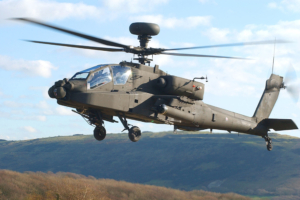Army Air Corps

The Army Air Corps (AAC) is the combat aviation arm of the British Army. Recognisable by their distinctive light blue berets, AAC soldiers deliver firepower from battlefield helicopters to overwhelm and defeat enemy forces.
The AAC has had two distinct and very different incarnations. It was first formed on 21st December 1941 as the overall Corps for The Parachute and Glider Pilot Regiments. These regiments had been formed in 1940 and 1941 respectively in response to the Germanys’ use of paratroops and gliders early on in the Second World War. The Corps also administered the Air Observation Post Squadrons of the Royal Artillery. These Units were the successors to the aircraft-flying artillery spotters of the First World War.
During airborne operations, troops either jumped into action from aircraft or were loaded into gliders with their weapons and vehicles. They were towed to the drop zone by Royal Air Force aircraft. Upon landing, the glider pilots fought alongside their infantry passengers. The Corps and its constituent units saw action in the airborne landings in Sicily (1943), Normandy (1944), Arnhem (1944) and the Rhine crossings (1945). The Special Air Service (SAS) joined the Corps in March 1944.
In August 1949, the Army Air Corps was broken up. The SAS regained its independent status, while The Parachute Regiment and The Glider Pilot Regiment formed a new Glider Pilot and Parachute Corps. Many of the glider pilots at that time, transferred to flying powered aircraft with the RAF Air Observation Post (AOP) Squadrons.
In 1957, The Glider Pilot and Parachute Corps was renamed – The Parachute Regiment. The Glider Pilot Regiment merged its remaining personnel with the AOP squadrons to form a new Army Air Corps. This second AAC soon began to equip with helicopters as well as fixed-wing aircraft.
The AAC was initially used for reconnaissance, directing artillery fire and general transport flying duties. It started this combat role in Malaya (1948-60), Borneo (1962-67) and Aden (1964-67). The Corps formally became a direct-fire arm in 1972.
The AAC, supported by REME Aviation, sent detachments to the Falklands War (1982) and the Gulf War (1990-91), and also regularly operated in the counter-terrorism role in Northern Ireland (1969-2007). The Corps first deployed to Afghanistan in 2006 and went on to regularly support 16 Air Assault Brigade. Its offensive role in Afghanistan included the use of Apache AH64 attack helicopters.

The AH-64E Apache is currently being delivered to the AAC to replace the AH1, which is due to be withdrawn from service in 2024.
